Yes we do love to be beside the seaside. Wild it can be, but for holiday purposes those of us who are relatively well-heeled prefer it to be domesticated, and so we import urban comforts and infrastructure, profoundly altering the nature of the coast.
Developing coastal lands into holiday and residential centres has far reaching consequences. The sad paradox is that by loving nature and wanting to be in it we can damage it, and in the process irretrievably lose what attracted us in the first place.
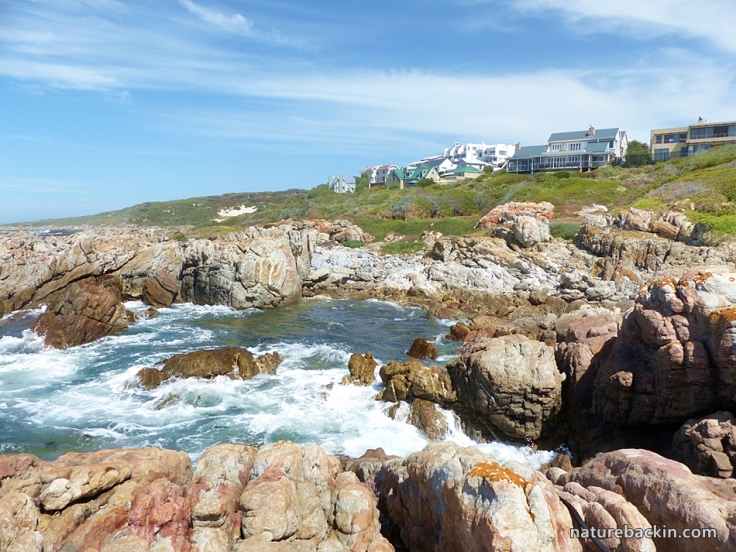
A recent visit to a coastal area of the Western Cape, South Africa, made me think about the ongoing suburbanisation and taming of the seaside
Seaside infrastructural development severely modifies natural habitats, and the consequent increase in the numbers of people places huge pressures on the environment. In addition to the proliferation of buildings, roads and traffic, pressures include an ever growing demand for water, and the burden of disposing of household waste and sewage.

Coastal development – an environmental balancing act
A 2014 Australian report (Victorian Coastal Council) on population growth in coastal areas gets to the nub of the dilemma: “Our passion for the coast creates ongoing and increasing pressures on the very aesthetic, cultural and environmental values we love”.
The report sums up consequences of rapid development in coastal areas: “Coastal growth can lead to biodiversity and habitat loss, water degradation in coastal waters, wetlands, lakes and rivers, coastal habitat loss, damage to wetlands, the introduction of pest plants and animals, coastal erosion, destruction of coastal ecosystems, loss of cultural heritage, conversion of productive agricultural land and impacts on scenic coastal landscapes, views and vistas”.
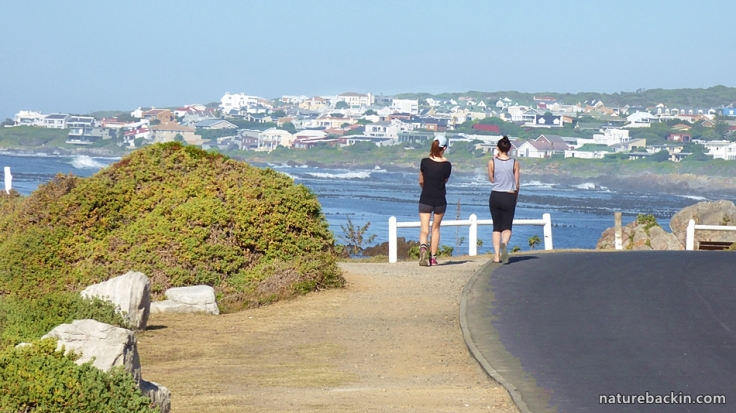
The report also notes social consequences: “Socially, it can lead to pressures on the particular values and character of coastal areas and settlements – the very reason people choose to move to or visit a place. This pressure is particularly intense in coastal areas experiencing rapid growth and gentrification. It can also lead to community instability associated with a high turnover of residents. In settlements that experience high levels of tourism and high ratios of second home owners to permanent residents, these impacts can be more pronounced”.

Tourists may regard small fishing vessels as picturesque, but families in communities that survive largely through small-scale fishing are generally marginalised in the gentrification processes of seaside resort development. (My spouse took this photo – pushing the zoom lens to its limit produced an unexpected painterly effect.)
Further to the expansion of infrastructure, recreational activities at the beach also impact on wildlife, vegetation and waterways. Disturbance, displacement and trampling all do their damage. Perhaps we can consciously try to minimise such intrusions.
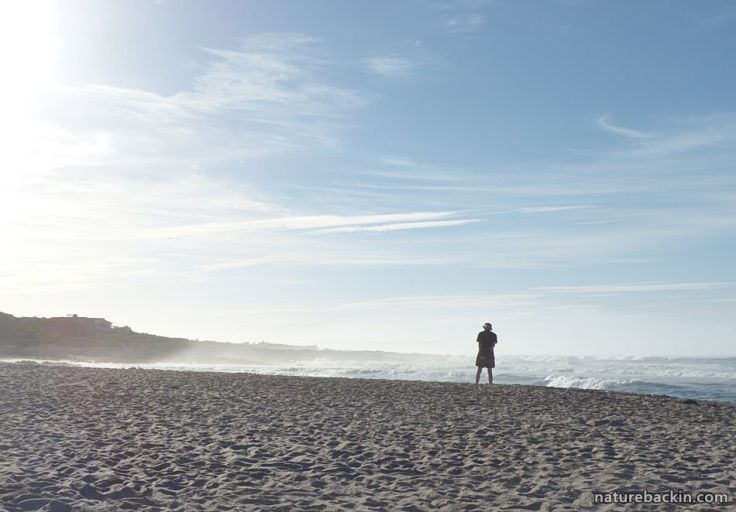
Leave only footprints
Many shorebirds nest on the ground. For instance, the White-fronted Plover nests in a scrape it makes in the ground above the high-water mark. During the day, nesting adult birds need to protect eggs and chicks from the heat of the sun, and should parent birds be frightened off their nests the heat from the sun can kill the eggs or chicks within a very short space of time.
Data collected by Shorebird Research working through the Nature’s Valley Trust (NVT) in beach areas in the Garden Route on the southern coast showed that plovers will leave their nests when approached at a distance of about 30 metres and will only return to the nest when the threat is at least 30 metres away, so if a visitor lingers in the vicinity, the bird will not return to its nest. On a hot summer day an egg can overheat in five minutes.

A White-fronted Plover on a popular beach. The number of White-fronted Plovers in the Western Cape has dropped dramatically over recent decades, more so in open-access areas popular with beach visitors. Across its range the population of these plovers has dropped by 40-60% over the last 30 years
Information gathered on White-fronted Plovers during the research process at Nature’s Valley led to the #Share our Shores campaign, which spreads awareness of threats to shorebirds. Signs erected at beaches indicate the proximity of nests and where dogs can be walked off leash, on a leash only, or where dogs are not allowed at all. Visitors are advised to walk near the waterline and avoid the dunes. Such simple measures can protect nests.
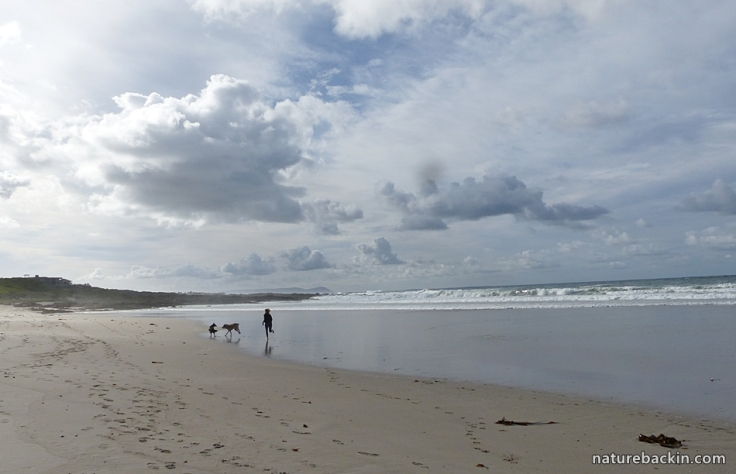
At the beach dogs should be kept close to the water line and under control to reduce disturbance to shorebirds, including birds nesting on the beach above the high water mark and in the dunes
The public awareness campaign and dog-walking regulations at Nature’s Valley have made a positive impact on the breeding success of the White-fronted Plovers. Researchers compared data from the 2017/2018 breeding seasons to data from previous seasons. The data showed an increase in breeding success from 10.6% (2015/2016) to 14.3% (2017/2018) on one beach, and 8.6% (2014/2015) to 30.5% (2017/2018) on another. (For more information on this project, including a video, see here)
The peak breeding season for many shorebirds is in summer, which coincides with the peak holiday season. Recreational activities at beaches often disturb breeding birds. Beach driving by off-road vehicles poses a particular threat as in addition to frightening parents away from nests, vehicles churn up the sand, run over nests and kill fledglings hiding in the tracks. Fortunately beach driving has been banned in many regions.
The ban on beach driving is thought to have contributed to an increase in the breeding success of the African Black Oystercatcher, a species that occurs only in southern Africa. Another contributing factor to their improved breeding success is the end of guano collecting (in the 1980s) on offshore islands where about 30% of African Black Oystercatchers are found.
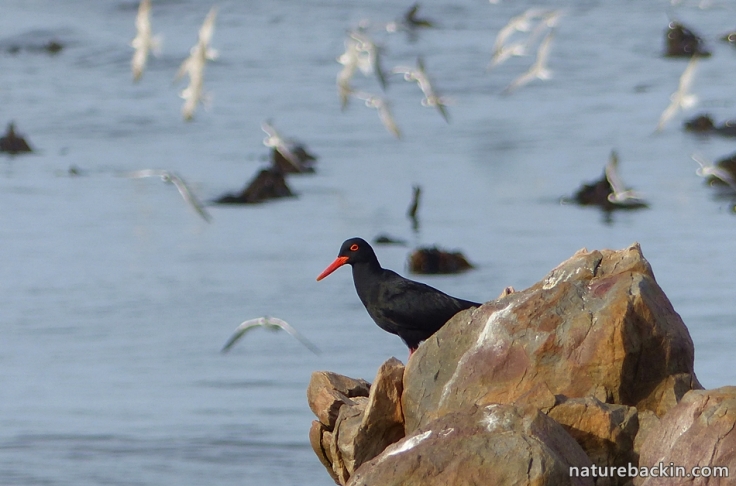
The status of the African Black Oystercatcher has recently been recorded as ‘least concern’ on the IUCN Red List of Threatened Species, whereas previously it was classified as ‘near threatened’
Another factor in the increase in the population of these oystercatchers is the spread of the invasive non-indigenous mussel Mytilus galloprovincialis, which has increased the level of food available to these birds.
Despite threats to African Black Oystercatchers, which include coastal development and natural predation, a relatively good-news story is that the population of these slow-breeding shorebirds has increased by 30% since the 1980s, indicating that conservation interventions, such as banning beach driving, can have a positive effect.
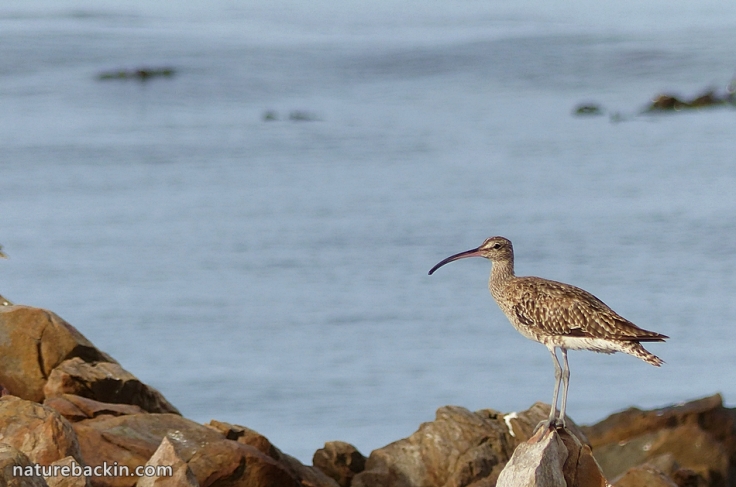
Another shorebird, the Whimbrel is a non-breeding migrant to southern Africa, with most birds here migrating from eastern Russia and Siberia where breeding takes place. Although numbers are declining, the decline is not as rapid as for some other migrating shorebirds
Generally the plight of shorebirds is not encouraging. A recent article in the New York Times, titled ‘Shorebirds, the world’s greatest travellers face extinction’ speaks of the decline in shorebirds worldwide as a conservation crisis. The main factors in the dramatic decline in recent decades are climate change, coastal development, the destruction of wetlands, and hunting. For fascinating accounts of the incredible migrations of shorebirds, and distressing information about the threats that they face you can read the article here. Just as these birds depend for their survival on “the shorelines of oceans, estuaries, rivers, lakes, lagoons and marshes”, so do we. It is argued in the article that the decline of shorebirds points to “a systemic crisis that demands our attention, for our own good”.
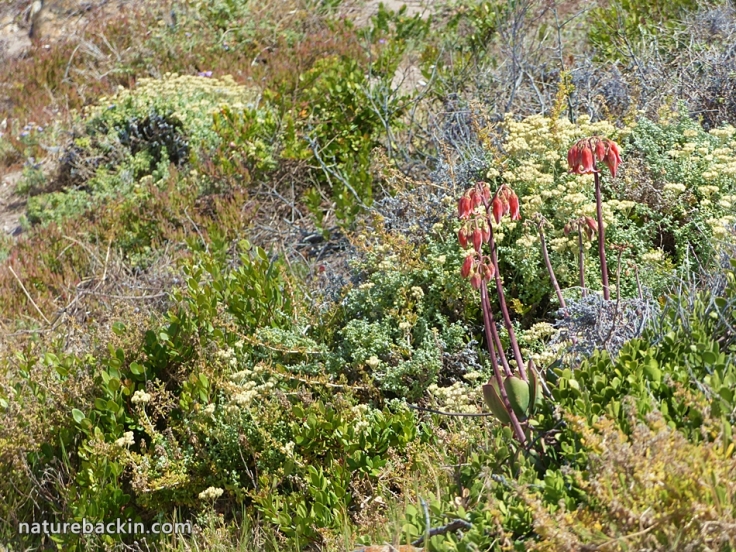
Coastal development also impacts on natural coastal vegetation and on the wildlife it harbours. Coastal biodiversity is under ongoing threat
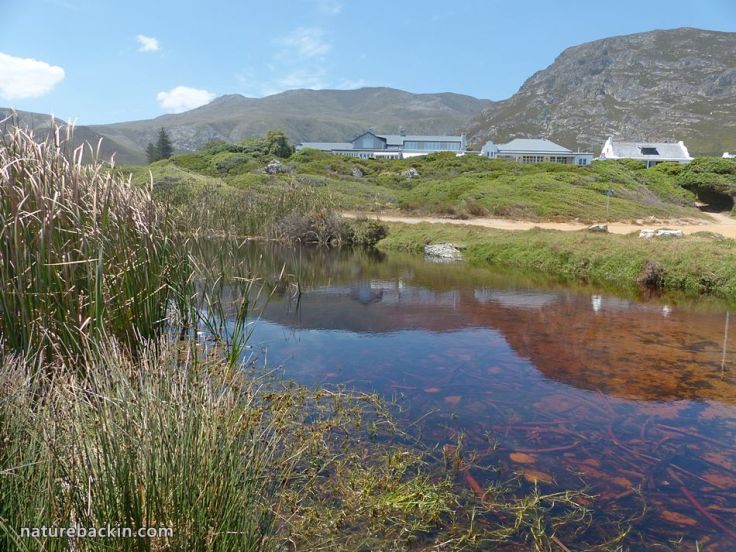
Waterways are vulnerable to pollution. Infrastructural development can threaten the health and even the existence of wetlands and waterways
Posing questions is much easier than finding answers. In the face of the bigger questions, perhaps it is self-indulgent to think that small actions by individuals can add up to anything meaningful?
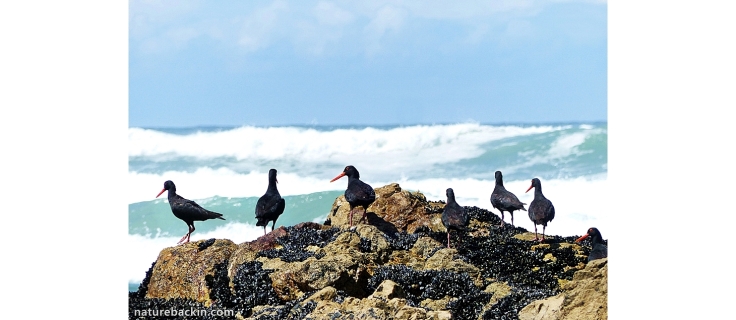
Who should be entitled to a sea view?
Sources: Fitzpatrick, John W. & Senner, Nathan R. 2018. Shorebirds, the world’s greatest travellers face extinction. New York Times, April 27. https://www.nytimes.com/interactive/2018/04/27/opinion/shorebirds-extinction-climate-change.html; IUCN Red List of Threatened Species. 2017. Haematopus moquini (African Black Oystercatcher, African Oystercatcher) http://www.iucnredlist.org/details/22693627/0; Percy FitzPatrick Institute of African Ornithology. 2015. Biennial Report 2013-2014. http://www.fitzpatrick.uct.ac.za/sites/default/files/image_tool/images/275/About_Us/Annual_Reports/Biennial%20Report%202013-2014.pdf; Nature’s Valley Trust (NVT). Shorebird Research Anthropogenic disturbance on shore breeding birds. https://www.naturesvalleytrust.co.za/programmes/ecological-research/fisherman-ecological-impact-program/shorebird-research/; Victorian Coastal Council. State of Victoria. 2014. Population and Growth: Victoria has experienced unprecedented population growth along the coast. http://vcc.vic.gov.au/page/victorian-coastal-strategy/population-and-growth
Posted by Carol









June 16, 2018 at 10:07 am
Margaret and I are in different parts of the Uk and mine being a coastal county, we have all the problems you describe, Carol. It’s heartening to be reminded that as Margaret says, quite a lot of our coast is less attractive to humans for the reasons Margaret describes. The picture is different down here.
On the back of your excellent post, I’ve just spent a depressing few minutes reminding myself of the various coastal building projects underway around Cornwall’s most famous beaches. Were you to see Cornwall it would be hard to accept that it’s the poorest county in England but apparently that’s the case, especially noticeable in the far western towns. Yet we have numerous high-end projects going up for the wealthy and the tourist trade – tourism of course, is a vital part of the local economy so these projects will create jobs and bring in income. But where does this leave the wildlife and the natural environment? Inland it is less of a problem – Bodmin Moor is now one of the few internationally designated dark sky areas, for example. And I still see stretches of unspoilt coastal landscapes, plenty of them in fact, when I think of the coast along the southern part of England, much of which feels like a continuous conurbation.
None of this offers any constructive response to your argument. But in response to the question of whether individuals’ contributions can add up to anything meaningful, we must surely hope that they can and that they will. Education, raising awareness… even the smallest contributions are better than no contributions at all. Is it self-indulgent to think this way; are we deluding ourselves; do we simply want to feel less uncomfortable about the realities of the big picture? Perhaps. But it has to be better than the alternatives sitting back and doing nothing, or giving up.
🙂
LikeLiked by 1 person
June 17, 2018 at 9:41 am
Thanks Sandra for your thoughtful comment. I hope that Cornwall does not lose the characteristics that made it famous in the first place and that developments are regulated ito of environmental impact. You rephrase the question related to possible self-delusion very well. I think we do need to ask these questions and remind ourselves that there should be no comfort in complacency, On the other hand despair is not helpful either. So I guess that, as ever, we can try to chart a middle way.
LikeLiked by 1 person
June 16, 2018 at 4:02 am
A thoughtful and informative post Carol. I’ve failed to compose a response without descending into a rant, but I suppose I could sum it up by saying that my greatest hope for the preservation of the Earth and the vast majority of life on it, is the rapid extinction of the human race. Sorry to be so bleak.
President Trump, in his inimitable way, summed up why our coastlines will always be in trouble when, at his recent summit, he raved about how North Korea’s coastline just cried out for development. And don’t worry about sea level changes because global warming is ‘fake news.’
I think I’d better just crawl into a corner, curl up, and weep quietly. Before I go though, yes, individuals should do what they can. It’s always meaningful if it’s sincere, and like many things, initiative and change will come from the bottom, not the top.
LikeLiked by 1 person
June 16, 2018 at 6:05 am
Thanks Graham. I think the removal of environmental oversight in the US, the promotion of unfettered development and the denial of climate change are distressing enough to make a rant entirely reasonable. Horrid to think of yet more coastlines being destroyed with no thought of the consequences. It is hard not to be bleak. One does not need to be apocalyptic to be fearful of the consequences of our destructive short sightedness. Perhaps pressure to change incrementally from the bottom is the best we can hope for. As somebody said, it’s better to light one candle than be overwhelmed by the darkness …
LikeLike
June 17, 2018 at 4:26 am
The only consolation about rising water levels is that some of the first people to be affected will be climate change deniers who built palaces on the beach. Then wait for them to start whining about how the government should do something about it. On a more cheerful note, is there a more fun bird to watch than oystercatchers?
LikeLiked by 1 person
June 17, 2018 at 10:36 am
Yup. Odd how those who are grandly against government intervention can so quickly change their tune when it suits their interests! Yes, oystercatchers are fun to watch as they seemingly play dare with the waves while foraging for mussels. The oystercatchers where I have seen them have been wary and keep their distance. Probably wise …
LikeLike
June 16, 2018 at 3:20 am
Please delete the comment that WordPress posted before I had corrected it… the last sentence should read “NOT the least bit civilized.”
LikeLike
June 16, 2018 at 5:25 am
I have done so. So annoying when send happens before it should!
LikeLiked by 1 person
June 16, 2018 at 3:18 am
We share some of the same problems you write about. One of the many places being loved to death is a section of the southern California Coast called Big Sur. The mobs of people visiting a narrow highway that hangs on the edge of steep cliffs hanging over the ocean, They have traffic jams (year round these days, not just during tourist season), not to mention mudslides sending the road into the ocean and wildfires (some started by tourists leaving illegal campfires burning.) It’s all a horrendous mess for the folks who were lucky to live there. Not so much these days.
Some of our National Parks aren’t hardly worth going to these days because of the mobs. So far, our coastline is still bearable… probably because the roads over the coastal range of mountains haven’t yet been developed into superhighways and there aren’t any major metropolitan areas within easy reach.
In a lot of ways we’re not the least bit ‘civilized’…
LikeLiked by 1 person
June 16, 2018 at 5:55 am
This is so depressing. It’s odd how so many people who take the trouble to go out into nature take the noise and technology of urban area with them, and in so doing mess up the natural area they visit and show it no respect or sensitivity. If they need the noise, equipment and partying why do they not visit areas more suited to their requirements? We have similar issues and visiting so many well-loved places is no longer tolerable here too. Sometimes I am ashamed of our fellow humans’ selfish ways.
LikeLike
June 15, 2018 at 10:35 pm
Those who claim they learn something reading my blog need to read your posts!
LikeLiked by 1 person
June 16, 2018 at 5:34 am
Oh Abrie, what an incredibly kind thing to say! Thank you.
LikeLike
June 15, 2018 at 12:14 pm
Excellent observations, Carol.
We must all do our ”bit” …. even if that bit is small.
Every bit counts.
The photos are a treat.
LikeLiked by 1 person
June 15, 2018 at 8:02 pm
Thanks so much Ark. I do like to think that every bit counts, but even adding it all up, it can seem so inadequate in the face of all the onslaughts and complexities.
LikeLiked by 1 person
June 15, 2018 at 8:27 pm
Well, I have begun picking up litter on my walk /jog route every morning and even though I only pick up a few bits it is already making a difference.
LikeLiked by 1 person
June 15, 2018 at 9:07 pm
You are right. We can do what we can do. Better than being overwhelmed.
LikeLike
June 15, 2018 at 9:57 am
Wonderful article Carol. And some pictures included are familiar! I especially loved the video of the dangers facing the white breasted plover
LikeLiked by 1 person
June 15, 2018 at 7:57 pm
Thanks Suzette – thought of you when I was choosing the photos. I am glad that you checked out the video. Interesting work they are doing re the plovers.
LikeLike
June 15, 2018 at 8:28 am
As you’ve noted in your post, we have the same problems here. And Australia being the largely dry and often inhospitable land that it is, a large percentage of the population lives close to the coast, with coastal areas and wildlife more and more under threat. Towns that were once small and quaint now have satellite suburbs of large houses and many of these houses are only used for holidays.
LikeLiked by 1 person
June 15, 2018 at 7:54 pm
I suppose sensitive planning and sensible regulations might mitigate the impact, but is there the will and wherewithal to do even this? The issue of holiday homes is a vexed one indeed.
LikeLiked by 1 person
June 15, 2018 at 7:22 am
This is a brilliant, thoughtful post. In this country, we – or the inhabitants of the natural world – are perhaps fortunate that many coastal sites are relatively inaccessible (cliffs, marshes etc) or suffer from the kind of weather that doesn’t encourage sunbathing. Not that we don’t suffer from the kind of issues you write compellingly about. In Europe, it’s Spain that may have seen the worst of insensitive over-development of once gloriously wild coastal areas. As they now realise, in many cases far too late. In these kind of situations, it’s hard to see how individuals can meaningfully do anything much. Worrying.
LikeLiked by 1 person
June 15, 2018 at 7:47 pm
It is worrying. Perhaps there are organisations and lobby groups that could do with more support from those who are concerned about such issues. I wish that environmental impact assessments done prior to new developments were actually more meaningful and carried more weight than they seem to in practice.
LikeLiked by 1 person
June 15, 2018 at 4:57 am
This is an article worthy of a w-i-d-e audience. I have found it both interesting and informative. It reminds me of areas of natural beauty around the country that are opened up for housing development – the beauty of the area being a selling point – and within a relatively short space of time all that ‘natural beauty’ is tarred / bricked and covered with houses and gardens that support the same old, same old alien trees/ bushes/ flowers …
LikeLiked by 2 people
June 15, 2018 at 5:31 am
Thanks Anne. You capture my concerns exactly.
LikeLike
June 15, 2018 at 2:01 am
What a fantastic article, Carol, with much food for thought. Let us take it to heart!
LikeLiked by 1 person
June 15, 2018 at 5:28 am
Thanks. I really appreciate your comment. It is food for thought but I thought I might have bitten off a bit more than I could chew ☺
LikeLiked by 1 person
June 15, 2018 at 6:18 am
You did a brilliant job, really
LikeLiked by 1 person
June 15, 2018 at 7:36 pm
Thank you very much.
LikeLiked by 1 person